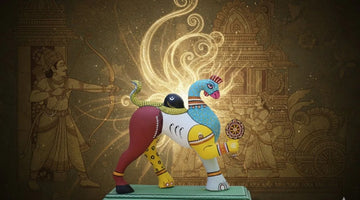Beyond mythology, the real Navagunjara meaning lies in cosmic unity, divine imagination, and the infinite inventiveness of Indian spirituality. This legendary figure from the Mahabharata symbolizes the union of nine different animals into a single divine being.
Lord Krishna appears before Arjuna in the Odia adaptation of the epic as Navagunjara, a strange yet magnificent form that forces Arjuna to see past appearances and acknowledge divinity in all forms.
In contrast to many mythological animals that can be found all over India, Navagunjara is specifically associated with Odisha's artistic and cultural identity. Its imagery can be found in handcrafted sculptures, temple carvings, and Pattachitra paintings, all of which tell tales of cosmic wholeness, balance, and faith.
Origin & Historical Context: Navagunjara in Texts and Tradition
Navagunjara's roots can be found in the 15th-century Odisha medieval retelling of the Mahabharata by poet Sarala Dasa. In this version, Krishna tests Arjuna's spiritual wisdom and humility by taking on the form of Navagunjara.
Combining the Sanskrit roots "Nava" (nine) and "Gunjara" (animal or sound), the term Navagunjara refers to "a being of nine forms." It is frequently written as Nabagunjara in Odia, and both spellings are recognized in local literature and customs.
Some academics believe it to be a spiritual metaphor, an artistic expression of Vishnu's universal form, while others link its visual inspiration to exotic animals that were brought to India through trade.
Carvings of Navagunjara, which represent divine inclusivity, adorn the walls of temples in Odisha, especially Puri's Jagannath Temple. Its inclusion in hallowed architecture demonstrates the legend's close ties to regional devotion and beauty.
We’ve explored this mystical creature in depth. Read the divine story and symbolism of navagunjara in odia art & culture.
The Navagunjara Story: Arjuna’s Divine Encounter

In the Mahabharata, the Navagunjara story takes place during Arjuna's exile. Arjuna sees a remarkable creature while meditating on Lord Krishna. It is a hybrid of a peacock, bull, lion, snake, elephant, and human.
The anatomy of the creature is explained in detail:
- A rooster's head, representing awakening.
- Peacock's neck, which stands for elegance and beauty.
- Back of a bull, representing fortitude and tenacity.
- Lion's waist, signifying bravery and nobility.
- Elephant trunk, representing memory and wisdom.
- Serpent's tail, which stands for change.
- Three elephant, tiger, and deer legs that combine strength, stability and gentleness.
A lotus, which stands for purity and consciousness, is held in one human arm.
Arjuna first gets ready to shoot, startled by its strange appearance. However, as he looks at the lotus in its grasp, he understands that it is actually Krishna himself, appearing in an enigmatic and unfathomable form. Arjuna bows before the creature, overcome with humility.
Arjuna and the reader learn from this instance that divine truth is greater than human reason. The episode from the Navagunjara Mahabharata represents acceptance of divine mystery, understanding and surrender.
Decoding the Symbolism: Navagunjara as a Cosmic Metaphor

One must see Navagunjara as a tapestry of symbolism in order to comprehend its meaning. The blueprint of universal harmony is formed by the aspects of creation that each animal part represents.
- The rooster signals the coming of dawn, or consciousness.
- The peacock is a symbol of spiritual dance and beauty.
- The bull is a symbol of dharma's stabilizing power and patience.
- The lion is a symbol of strength and power.
- The elephant represents wealth and intelligence.
- The serpent is a symbol of eternal energy and metamorphosis.
- In the midst of life's chaos, the lotus symbolizes the blossoming of consciousness.
These nine components work together to reflect the divine complexity of nature, demonstrating how opposites can coexist peacefully. Accordingly, the Nabagunjara legend acknowledges that unity is the ultimate form of wisdom and that all life possesses divine essence.
From a philosophical standpoint, the creature symbolizes Vishwaroopa, the universal manifestation of Vishnu, in which all entities, attributes, and forces coexist in divine symmetry.
Variations, Artistic Representations & Cultural Continuity
The Navagunjara tale has grown to be a fundamental component of Odisha folk art over the ages. Its visual narrative keeps changing, from old palm-leaf manuscripts to contemporary home décor.
Navagunjara is still portrayed in colorful Pattachitra art by artists from Raghurajpur, the renowned craft village in Odisha. The intricate details of the creature, such as its flowing lines, symmetrical balance, and conventional colors, are the result of generations of artistic discipline.
Navagunjara is frequently carved next to representations of Vishnu's avatars in the Jagannath Temple in Puri, which is one of the temples in Odisha where the motif is also found in stone carvings.
Exhibitions of Indian folk art in recent years have brought Navagunjara's symbolism international recognition. It is viewed by collectors and cultural organizations as a link between mythology and ecology, signifying unity, diversity, and divine coexistence.
The cultural inclusivity of the Jagannath tradition, which holds that all beings human, animal, and divine are members of the same cosmic family, is reflected in Odisha's distinctive regional interpretation of the Navagunjara Mahabharata, according to art historians.
Why Navagunjara Matters Today? Spiritual, Cultural & Aesthetic Significance
The Navagunjara meaning provides timeless wisdom in today's fractured world: the divine is not distinct from the diversity of the world; rather, it is a part of it.
Spiritually, it teaches that in order to see truth, one must see past fear or unfamiliarity. Arjuna's surrender represents enlightenment, and his hesitancy reflects humanity's battle with the unknown.
In terms of culture, Navagunjara represents Odisha's status as a place of creativity and inclusivity. It reflects how Indian spirituality flourishes on diversity rather than homogeneity by fusing tribal and folk aesthetics with Vedic philosophy.
It is one of the most artistically complex depictions of Indian myth because of its harmony of color, symmetry, and form. It symbolizes both devotion and design in handcrafted sculptures and wall art.
Mythological and regional art forms like Pattachitra play a major role in India's handicraft and heritage art market, which is valued at over US$3.5 billion from the standpoint of the cultural economy. Over the last five years, the demand for ethically made, narrative-based décor items has increased by almost 20% yearly, indicating a resurgence of interest in tradition through contemporary design.
This resurgence of interest highlights the ongoing influence of myths such as the Nabagunjara legend on design, sustainability, and mindful living.
Navagunjara and Maavni: Where Myth Meets Craft
In addition to being preserved in books and temples, Navagunjara's legacy is also carried on by craftspeople who continue to tell its tale. Maavni honors this tradition with its Navagunjara figurine collection, which draws inspiration from Odisha's traditional Pattachitra sculpture methods.
Each piece combines craftsmanship, spirituality, and cultural storytelling to depict the delicate balance of the nine beings. Maavni's authentic and meticulously crafted Navagunjara sculptures are more than just ornamental art; they are physical manifestations of India's never-ending conversation between design and divinity.
Selecting a Navagunjara figurine from Maavni ensures that the craft of telling stories through sculpture will continue to flourish while also bringing home a symbol of cosmic unity and helping Odisha's artisan communities.
Key Takeaways
- The meaning of Navagunjara is "the creature of nine forms," signifying the unity of God in diversity.
- Krishna first appears before Arjuna in this composite form in Sarala Dasa's Odia Mahabharata, which is where Navagunjara got its start.
- Every form of life is an expression of the divine, according to the Navagunjara story, which teaches that divinity transcends logic.
- Deep philosophical, artistic, and ecological lessons that are applicable to today's world are embodied in the Nabagunjara legend.
- Maavni preserves this legacy through its handcrafted sculptures and figurines, which bring Odisha's spiritual legacy into modern homes by fusing myth, culture, and artistry.
Conclusion: The Eternal Harmony of Creation
Navagunjara is more than a mythical being; it is a vision of unity in diversity and a celebration of divine imagination. From Arjuna’s awakening in the Mahabharata to the brushstrokes of Odisha’s Pattachitra artists, its story continues to inspire harmony between the spiritual and the artistic.
Every handcrafted Navagunjara sculpture or painting reflects this eternal truth that divinity exists in all forms of life. Through Maavni’s creations, this legend lives on connecting ancient wisdom with modern homes and honoring the soul of Odisha’s heritage.
FAQ’s About Navagunjara & Mahabharata
1. What is the spiritual meaning of Nabagunjara?
The spiritual meaning of Nabagunjara lies in unity and divine balance, it teaches that all forms of life are connected and that divinity exists in every being.
2. Who was the Navagunjara in Mahabharata?
In the Mahabharata, Navagunjara was Lord Krishna’s divine form that appeared before Arjuna to test his wisdom and reveal the truth of seeing God in all forms.
3. What does the Navagunjara symbolize?
Navagunjara symbolizes harmony, diversity, and the coexistence of all energies; animal, human, and divine within the cosmic order.
4. What are the powers of the Navagunjara?
Navagunjara’s power lies in its spiritual symbolism; it represents transformation, awareness, and the vision to recognize divinity beyond appearances.
5. What are the 9 animals of Navagunjara?
Navagunjara combines parts of nine beings: a rooster’s head, peacock’s neck, bull’s back, lion’s waist, elephant’s trunk, serpent’s tail, three legs of an elephant, tiger, and deer, and one human arm holding a lotus






